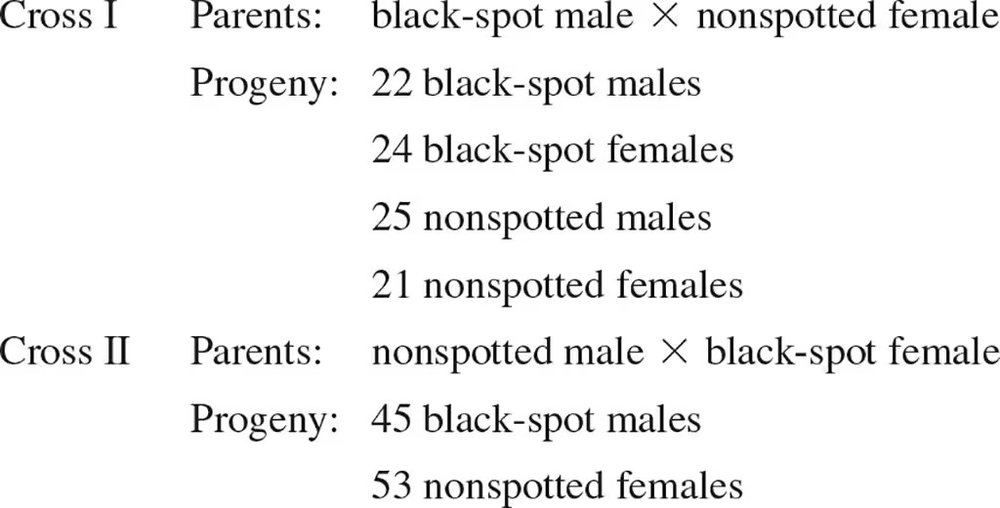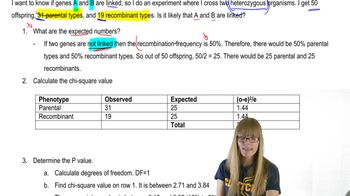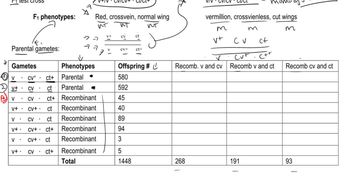The following figure illustrates reciprocal crosses involving chickens with sex-linked dominant barred mutation. For Cross A and for Cross B, cross the F₁ roosters and hens and predict the feather patterns of roosters and hens in the F2.
Table of contents
- 1. Introduction to Genetics51m
- 2. Mendel's Laws of Inheritance3h 37m
- 3. Extensions to Mendelian Inheritance2h 41m
- 4. Genetic Mapping and Linkage2h 28m
- 5. Genetics of Bacteria and Viruses1h 21m
- 6. Chromosomal Variation1h 48m
- 7. DNA and Chromosome Structure56m
- 8. DNA Replication1h 10m
- 9. Mitosis and Meiosis1h 34m
- 10. Transcription1h 0m
- 11. Translation58m
- 12. Gene Regulation in Prokaryotes1h 19m
- 13. Gene Regulation in Eukaryotes44m
- 14. Genetic Control of Development44m
- 15. Genomes and Genomics1h 50m
- 16. Transposable Elements47m
- 17. Mutation, Repair, and Recombination1h 6m
- 18. Molecular Genetic Tools19m
- 19. Cancer Genetics29m
- 20. Quantitative Genetics1h 26m
- 21. Population Genetics50m
- 22. Evolutionary Genetics29m
2. Mendel's Laws of Inheritance
Sex-Linked Genes
Problem 24a
Textbook Question
In a species of fish, a black spot on the dorsal fin is observed in males and females. A fish breeder carries out a pair of reciprocal crosses and observes the following results.

Why does this evidence support the hypothesis that a black spot is sex linked?
 Verified step by step guidance
Verified step by step guidance1
Step 1: Understand the concept of sex-linked inheritance. Traits that are sex-linked are typically associated with genes located on the sex chromosomes (X or Y). In many species, males are XY and females are XX, meaning that inheritance patterns can differ between sexes.
Step 2: Analyze the results of Cross I. In this cross, a black-spot male (XY) is crossed with a nonspotted female (XX). The progeny includes both black-spot and nonspotted males and females in roughly equal proportions. This suggests that the black-spot trait is not autosomal (not inherited equally regardless of sex) but may be linked to the sex chromosomes.
Step 3: Analyze the results of Cross II. In this cross, a nonspotted male (XY) is crossed with a black-spot female (XX). The progeny includes only black-spot males and nonspotted females. This pattern is consistent with X-linked inheritance, where the black-spot allele is carried on the X chromosome.
Step 4: Consider the inheritance mechanism. In X-linked inheritance, males inherit their single X chromosome from their mother and their Y chromosome from their father. Females inherit one X chromosome from each parent. The results of Cross II suggest that the black-spot allele is dominant and located on the X chromosome, as all males inherit the black-spot trait from their mother.
Step 5: Conclude why the evidence supports sex-linked inheritance. The differing patterns of inheritance between males and females in the two crosses, along with the observation that males inherit the black-spot trait only from their mother, strongly support the hypothesis that the black-spot trait is X-linked.
 Verified video answer for a similar problem:
Verified video answer for a similar problem:This video solution was recommended by our tutors as helpful for the problem above
Video duration:
2mPlay a video:
Was this helpful?
Key Concepts
Here are the essential concepts you must grasp in order to answer the question correctly.
Sex Linkage
Sex linkage refers to the association of a gene with a sex chromosome. In many species, certain traits are inherited differently in males and females due to the presence of these genes on the X or Y chromosomes. If a trait is sex-linked, it often shows different inheritance patterns based on the sex of the offspring, which can be observed in the progeny ratios from genetic crosses.
Recommended video:
Guided course

Chi Square and Linkage
Reciprocal Crosses
Reciprocal crosses involve mating two organisms in both possible combinations to determine the inheritance patterns of traits. By switching the sexes of the parents in the crosses, researchers can identify whether a trait is influenced by sex-linked genes or autosomal genes. The results from these crosses can reveal differences in trait expression based on the sex of the parent contributing the trait.
Recommended video:
Guided course

Trihybrid Cross
Progeny Ratios
Progeny ratios are the expected or observed frequencies of different phenotypes or genotypes in the offspring resulting from a genetic cross. Analyzing these ratios helps determine the inheritance pattern of traits. In this case, the differing ratios of black-spot and nonspotted fish in the progeny suggest a sex-linked inheritance, as the distribution varies significantly between the two crosses.
Recommended video:
Guided course

Organelle Inheritance
Related Videos
Related Practice
Textbook Question
426
views


